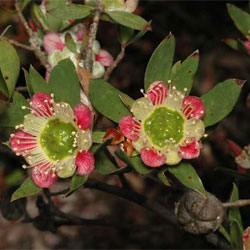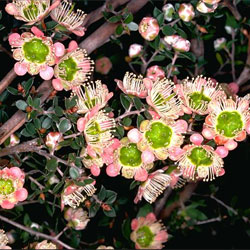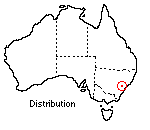Leptospermum macrocarpum
 |
 |
Large-fruited Tea Tree
Leptospermum macrocarpum (Maiden & Betche) Joy Thomps.
In Australia, Leptospermums are often called tea trees because early settlers are said to have made a tea-like infusion from the leaves. Sometimes an additional qualifier is added such as 'Lemon-scented Tea Tree', often based on their scientific name.
 This
large-fruited Leptospermum occurs naturally in the northern Blue Mountains,
west of Sydney, where it grows in poor sandstone soils on north-west slopes
at the base of cliffs, in full sun or part shade. It forms a low, scrambling
shrub usually 1 m high by 2 m across.
This
large-fruited Leptospermum occurs naturally in the northern Blue Mountains,
west of Sydney, where it grows in poor sandstone soils on north-west slopes
at the base of cliffs, in full sun or part shade. It forms a low, scrambling
shrub usually 1 m high by 2 m across.
In cultivation at the Australian National Botanic Gardens there are many plants of different ages, mostly forming compact, densely branching shrubs.
The foliage is dark green and slightly glossy; the leaves are oblong, about 2 cm long by 1 cm wide. The flowers of this variety are large for a Tea Tree, being 25 mm in diameter, with pink petals, whitish stamens and a conspicuous, green centre. Shrubs with pale green-yellow or dark-red flowers are occasionally seen. Flowering occurs in summer and autumn, and for the remainder of the year the shiny brown fruits, up to 25 mm in diameter, contrast well with the foliage. As flowering occurs on the new wood L. macrocarpum makes a useful cut flower.
Propagation is successful from seed, but for true-to-type plants cuttings taken in late autumn would be best. In cultivation L. macrocarpum grows best in a well-drained site, but seems to be adaptable to poorly drained soil.
At the Australian National Botanic Gardens it has been found to be frost hardy and may be grown in shrub borders or rockeries, in full sun or heavy shade. It may be pruned after flowering.
Unlike many Leptospermum species used in home gardens, for example L. scoparium cultivars, this species seems to be relatively free of pests and diseases.
Text by Stuart Donaldson, ANBG (1980)
Name meaning: Leptospermum macrocarpumLeptospermum - a Latinised Greek compound; lepto, from leptos, slender, and spermum, from sperma, seed; macrocarpum - a Latinised Greek compound, macro, from macros, large and carpum, from carpos, fruit, referring to the large fruit. |
![An Australian Government Initiative [logo]](/images/austgovt_brown_90px.gif)

